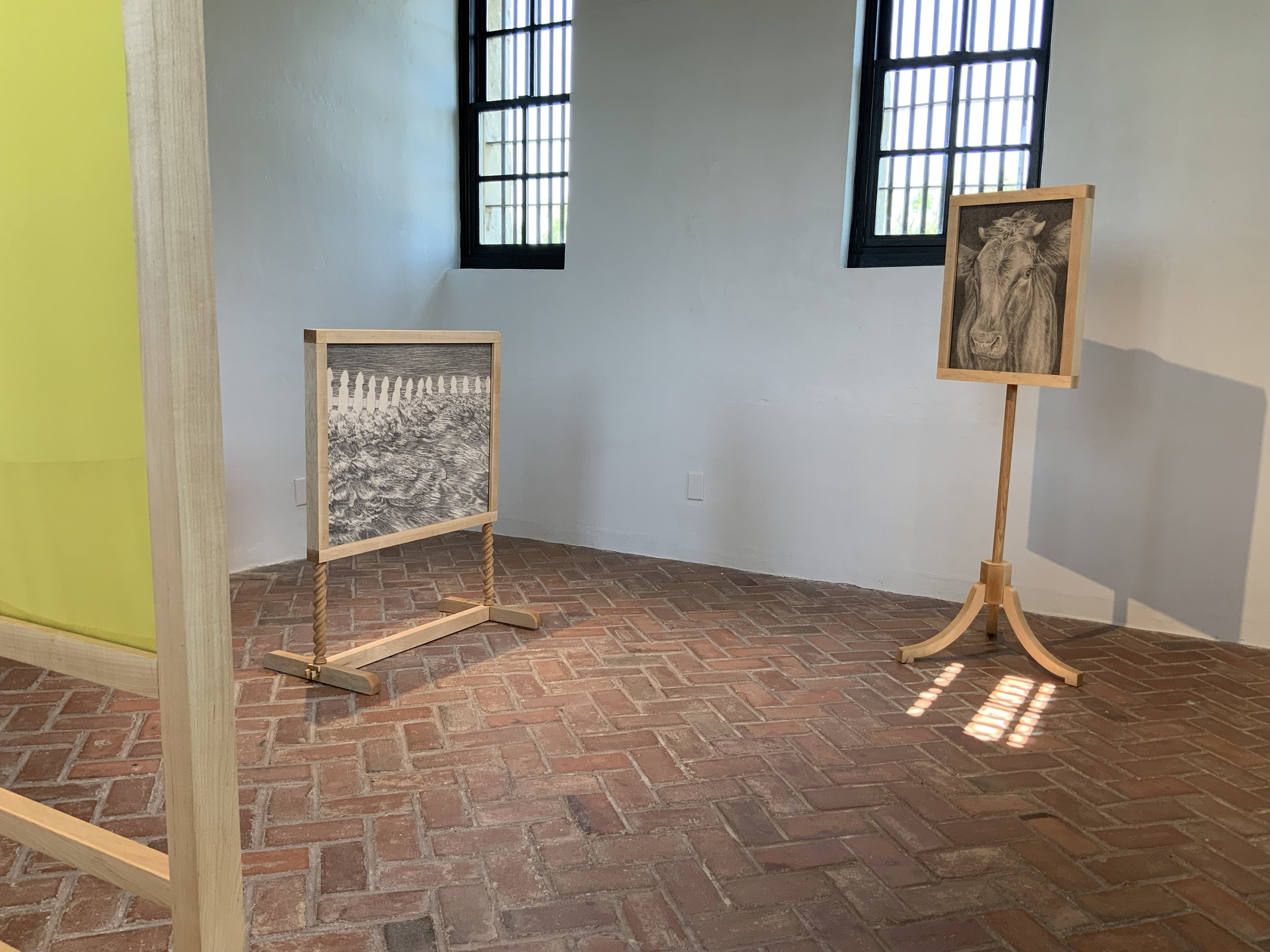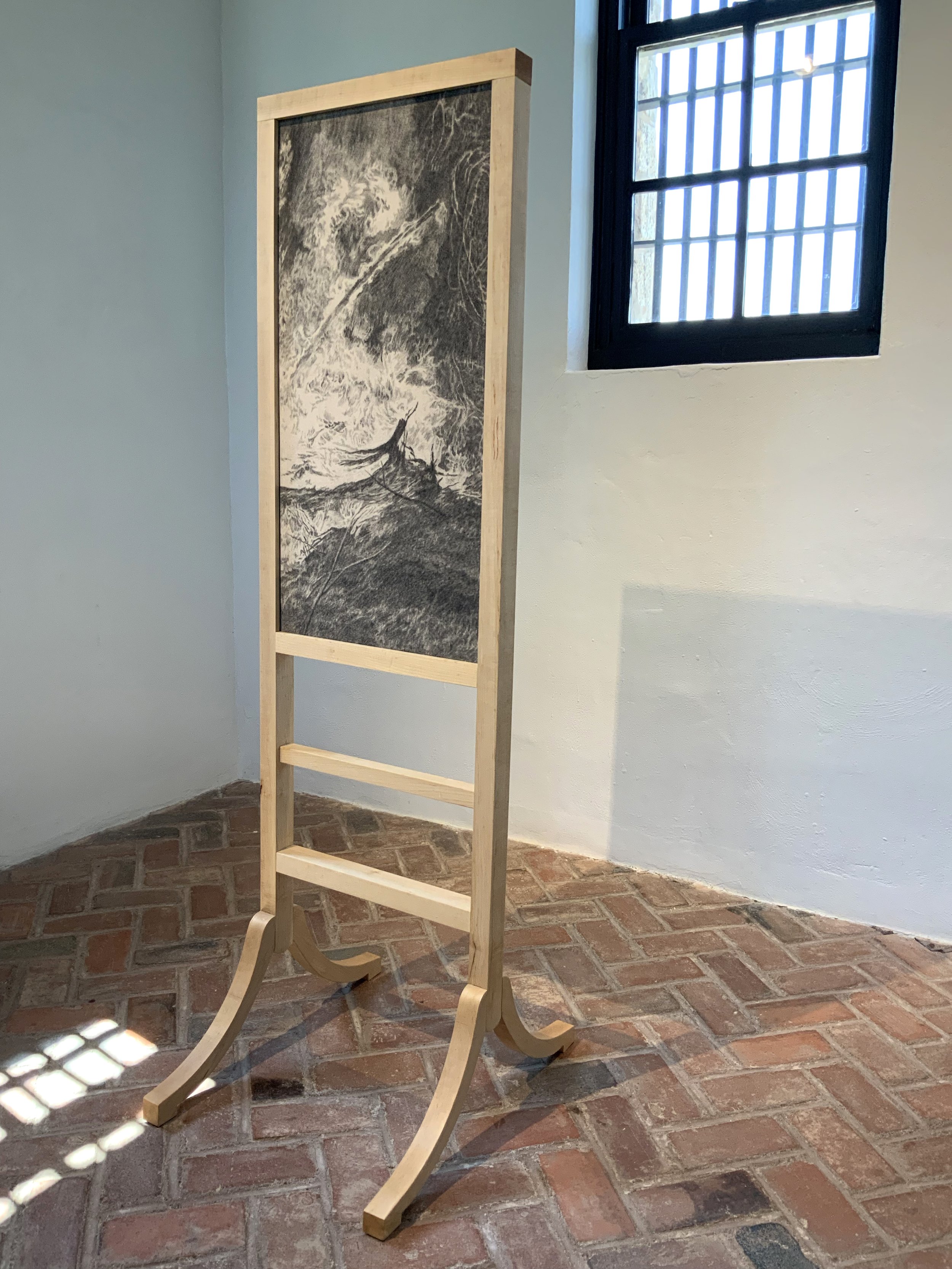Corrie Thompson makes drawings, books, and textiles that explore tensions between identity, loss, and place.
Thompson grew up between the United States, Solomon Islands, and Papua New Guinea and currently lives and works in Fort Worth, TX. As part of the OJAC’s Cell Series of exhibitions, Thompson explores elements of the Texas landscape in drought and deluge weather states, considering them as indicators of the state of the world. While looking through news articles and state archival materials, the artist admits she finds “poetic and bizarre moments in states of disaster.”
Thompson’s drawings on canvas and fabrics with applied text develop another layer of content within the confines of the OJAC’s historic jail structure that has witnessed more than 146 years of change.







Patrick Kelly, OJAC Director and Curator, Interview with artist Corrie Thompson.
PK: You were raised in some very unique locations; would you share those and the impressions they left on you?
CT: I spent most of my childhood in Solomon Islands and Papua New Guinea, where my parents worked in Bible translation, with brief stints in Australia, California, and Texas. So, I grew up in a postcolonial environment, in both the specific context of mission work and the broader socio-political history of those places. Upon returning to the United States in middle school, I struggled to understand where I could fit in the world. In my art practice today, I return to the context of my childhood to investigate the social structures and moral codes that impact both my past and present experiences.
PK: Can you elaborate on the social structures and moral codes? I’m assuming you are referencing the differences between cultures and societies as well as the perspectives of a child vs. an adult?
CT: My experience of often being an outsider to places means that I'm always looking for the behaviors and materials that signify being an insider. Every place seems to have specific languages of belonging—not just linguistic, but also behavioral, visual, geographic, etc. Moral codes are culturally specific definitions of ethical behavior; in other words, how people within a group understand living a good or right life, which often reveals underlying power dynamics. I'm interested in how the specifics of a place carry its history, which is typically shaped by larger social power structures like patriarchy, colonization, and religion.
PK: Given that, you moved back to Texas somewhat recently. Is that correct? Texas is a very complex place due to its size, diverse population, and history. From an “outsider’s” perspective, what are your major takeaways about Texas and/or its culture?
CT: Yes, I moved back to Texas in 2018 after having lived here for only a few years on and off with my family. Having grown up in-between places, I see Texas as an outsider in the same way that I encounter most American subcultures as an outsider. Texas has a big personality and intense state pride that I initially found hard to understand. But underneath the Texas-isms, I'm learning about historical threads that connect to other places I've lived, such as colonial history and the continued influence of the church, although they both manifest in unique ways here and are enmeshed in the cultural fabric. I'm also interested in the landscape, the ways that people live with (or in spite of) it; the weather events, and the changing climate. Becoming familiar with the Texas landscape in the last few years has been gratifying to my personal life and enriching to my work, where the imagery of natural forces is very much in conversation with earlier landscape themes.
PK: The natural environment has always been tumultuous in Texas with ideologies equally so. Let’s focus on the natural aspect—specifically weather/climate, as it relates to your exhibit Drought and Deluge. Would you speak about the overall theme and the elements that you created for inclusion?
CT: The cycle of drought and deluge is a well-documented characteristic of the Texas climate. I’m intrigued by the accepted inevitability of that, as well as the fact that cycles of disaster are shadowed by cycles of loss, tenacity, and re-growth. The work in this show comes from everything I’ve researched in the past year or so about the effects of weather in Texas, including news articles, state archival materials, first person accounts, public planning documents, Google image searches, etc. There are three drawings installed in fire screen structures, three cloth banners, and a cloth book that visitors can read. The banners and the book feature text excerpts from my reading, which I would write down whenever something alluded to grief and dread, regardless of the apparent intent of the original document. I also kept noticing mention of cattle in these records, which I immediately connected to memories of Bible stories—the golden calf, the cows of famine in Pharaoh's dream, sacrificial cows, and even the beast in the book of Revelation— and those allusions began finding their way into the work, too. The cow brings this Biblical/supernatural thread into the visual language of the show, and serves as a symbol for the tangible effects of extreme weather events in Texas.
PK: The banners and fire screens act as frameworks to present some of the drawings. What inspired those decisions beyond the obvious “fire” theme for the screens?
CT: I often look for historical objects or ways of making, especially from the colonial and Victorian eras, that I can use as a framework to consider where we come from and what our present looks like.
During graduate school I became interested in things that function as literal and/or figurative barriers/boundaries/screens. So, I returned to that interest when I was thinking about what to make for the jail cells. Fire screens are decorative furniture, often featuring floral needlepoint pictures, that were popularized in the eighteenth century to cover the fireplace when it wasn't in use; or in the case of the pole screen, to block direct heat from a person sitting by the fire. The rumor that I really love about the pole screens is that they were specifically meant to prevent one's makeup from melting. Whether or not that is true, it does get at the vanity that I think defines these objects. They were to protect one from discomfort and unsightliness, and to show off domestic skill through the art of needlepoint, which was associated with class-appropriate gendered labor. I like the irony of using a fire screen to call attention to an issue rather than to cover it. Plus, putting the drawings into a freestanding form gives them a different sense of agency than they might have on the wall. They become body-like.
The banners came out of a desire to feature longer sections of text than I was including in the book, because I found a few quotes that could function as cornerstones for the body of work. I initially thought I would reinvent altarpieces as a format for these texts, but then I found some archived photos from the Fort Worth Star Telegram of champion stock show cattle decorated with shiny award ribbons and I just couldn’t stop thinking about them. The stock show ribbons made this perfect visual rhyme with banners that are used during events of the liturgical calendar. The banners go way back in church history, but in contemporary use, I've seen a lot of liturgical banners quilted or embroidered by women. No matter the context, banners have ceremonial, power-bearing, public-facing connotations. Of course, anyone could find the texts I've quoted in the public record, but I'm interested in how their nuances shift when they're viewed in this new format.
PK: Would you share one or two banner texts and what initially struck you about them?
CT: It may help to explain the context of the shortest quote. It's from Volume 2 of 12 of the Pacific Railroad Survey Reports published by the US Department of War in 1855. This was a survey of potential routes for a railroad connecting the eastern United States with the newly-inducted western states. Several teams explored, documented, and recommended different paths for the railway. The text I drew on the banner is from the report on the area between the Trinity and the Brazos rivers in which the writer is absolutely gushing about the land. His rich language brings to mind the romantic paintings of the period, but what strikes me the most is how he concludes that the only thing lacking in the landscape is the "white village or stately house." To me, this phrase encapsulates the pervasiveness of "manifest destiny," the term that was written in an 1845 essay supporting the annexation of Texas. The railroad was, in fact, built through the Trinity River watershed, and we can now recognize that the settlements that grew up alongside it came at great cost both to the original inhabitants of the land, and to the Blackland Prairie ecosystem. So, what strikes me about this quote is how underneath the beautiful language, there's this worldview of consumption and domination that directly resulted in violence.
PK: Do you expect that audiences will recognize any of the source references in the final works?
CT: I doubt that every bit of research will come through explicitly, but I try to include familiar elements that hint at embedded context. For example, another banner text comes from the biblical book of Genesis. It's the story of the Pharaoh's dream in which seven healthy cows are consumed by seven emaciated cows, interpreted as a prediction of drought and famine. Many people may be familiar with this Sunday-school story, but even without insider knowledge, it's pretty unsettling. The dream becomes a point of entry for those who are intimately familiar with biblical language as well as for those who encounter the story as newcomers, who might have a more objective read. And dreams carry symbolism, so this quote extends the possibility of symbolism to the other work, image and text alike. All of the work reinvents familiar objects such as books and furniture, and does so with domestic materials such as pillowcases and old blouses; I’m hoping that those elements will provide subtext while presenting a familiar face to the audience.
The 2023 Cell Series of Exhibitions is generously supported by McGinnis Family Fund of Communities Foundation of Texas, National Endowment for the Arts, and Kathy Webster in memory of Charles H. Webster, with additional funding from Lucy & Fowler Carter, Margaret & Jim Dudley, Jenny & Rob Dupree, and Dr. Larry Wolz.


